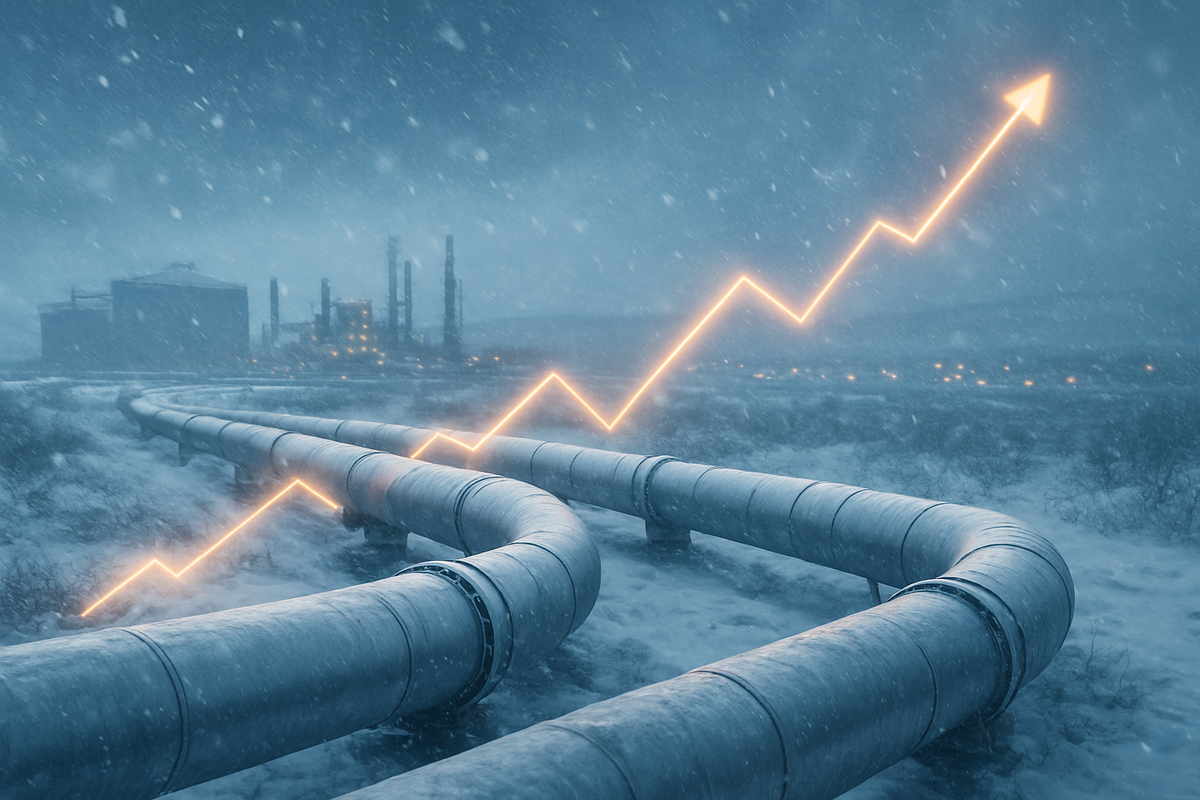
As the calendar turns towards the 2025/2026 winter withdrawal season, the U.S. natural gas market is poised for a potentially volatile period, with analysts eyeing a significant price rally. Driven by an anticipated surge in heating demand, robust liquefied natural gas (LNG) exports, and specific weather forecasts, natural gas futures prices, already on an upward trajectory, are expected to climb further. This looming rally could reshape profitability for energy companies, impact consumer utility bills, and intensify the global energy supply dynamic, marking a critical period for both domestic and international markets.
The current landscape, as of November 7, 2025, shows U.S. natural gas futures experiencing notable fluctuations, yet maintaining an underlying bullish sentiment. With the commodity historically rallying during the colder months when heating needs peak, market participants are closely monitoring storage levels, production forecasts, and the ever-present influence of geopolitical events. The interplay of these factors suggests that while current inventory levels appear robust, the sheer force of winter demand combined with an insatiable global appetite for U.S. LNG could quickly tighten balances and send prices soaring.
Detailed Coverage: The Perfect Storm Brewing for Natural Gas
The stage is set for a dynamic 2025/2026 winter withdrawal season in the U.S. natural gas market, with several converging factors pointing towards a potential price surge. As of November 7, 2025, U.S. natural gas futures have already demonstrated significant upward momentum, with the December 2025 NYMEX contract closing at $4.357/MMBtu on November 6, despite a slight dip to $4.280/MMBtu on the current day. This recent activity follows a nearly 30% increase in prices over the past month and a remarkable 62% rise compared to the same period last year, signaling a robust underlying strength in the market. The 12-month futures strip, encompassing December 2025 through November 2026, has climbed to an average of $4.050/MMBtu, with the CME winter strip implying prices peaking around $4.12/MMBtu for January 2026.
The primary catalyst for this anticipated rally is the inherent seasonality of natural gas demand, which experiences a substantial increase during the winter months for residential and commercial heating. This natural demand cycle is expected to be amplified by specific weather patterns. The National Weather Service's Climate Prediction Center forecasts a La Niña pattern for Winter 2025-2026, which historically brings colder conditions to the northern and western U.S., increasing the likelihood of significant heating demand spikes, particularly in the Midwest and Northeast. AccuWeather corroborates this, predicting a normal winter with blasts of Arctic air and heavy snow. Such cold outbreaks, coupled with the potential for a weaker Polar Vortex, could lead to rapid inventory drawdowns and localized price volatility.
Beyond domestic heating, the relentless growth in U.S. liquefied natural gas (LNG) exports is a critical bullish driver. The U.S. is projected to add over 5 Bcf/d in new LNG export capacity across 2025 and 2026, with several new Gulf Coast terminals coming online. This expansion positions LNG exports as the largest incremental demand increase, expected to rise by +3.8 Bcf/d year-over-year. Key players in this export surge include major LNG terminal operators like Cheniere Energy (NYSE: LNG) and emerging players bringing new facilities online. Europe's continued reliance on U.S. LNG to replace Russian gas, coupled with lagging storage refill paces in late 2025, ensures sustained strong export demand, effectively linking U.S. domestic prices to the tighter global market.
Initial market reactions reflect a cautious optimism among natural gas traders and analysts. While U.S. natural gas inventories are currently robust, projected to reach nearly 3,980 Bcf by the end of the injection season (5% above the five-year average), the market recognizes that sustained cold weather and high export volumes can quickly erode these reserves. The U.S. Energy Information Administration (EIA) projects the Henry Hub spot price to increase to $4.10/MMBtu by January 2026, averaging $3.90/MMBtu overall in 2026. This outlook, combined with forecasts of tighter supply-demand balances compared to the previous winter, underscores the potential for rapid price movements as the withdrawal season progresses.
Companies Poised for Gains and Losses in a Volatile Market
A significant rally in natural gas prices during the 2025/2026 winter withdrawal season would create distinct winners and losers across the energy sector. Natural gas producers, particularly those with substantial exposure to the Henry Hub benchmark, stand to benefit immensely. Companies like EQT Corporation (NYSE: EQT), the largest natural gas producer in the U.S., and other major players in the Appalachia, Permian, and Haynesville regions such as Chesapeake Energy (NASDAQ: CHK) and Antero Resources (NYSE: AR), would see increased revenues and improved profit margins from higher realized prices. Their ability to ramp up production efficiently or hedge effectively will determine the extent of their gains. Smaller, independent producers might also experience a lifeline or significant boost, especially if their cost structures allow for profitable operations at elevated prices.
Conversely, companies heavily reliant on natural gas as a feedstock or for power generation could face increased operational costs, squeezing their margins. Utility companies, such as NextEra Energy (NYSE: NEE) or Duke Energy (NYSE: DUK), which operate natural gas-fired power plants, would see their fuel expenses rise. While many utilities can pass on increased fuel costs to consumers through fuel adjustment clauses, there is often a lag, and sustained high prices can lead to regulatory scrutiny and potential political backlash. Industrial users, including chemical manufacturers like Dow Inc. (NYSE: DOW) or fertilizer producers, which use natural gas as a primary input, would also contend with higher raw material costs, potentially impacting their competitiveness and profitability.
Midstream companies, such as pipeline operators like Kinder Morgan (NYSE: KMI) and Energy Transfer LP (NYSE: ET), could experience mixed effects. While increased production and demand might lead to higher throughput volumes and associated tariff revenues, especially in constrained regions, they are also exposed to regulatory risks and the need for significant capital expenditure to expand capacity. The anticipated regional price volatility, particularly in the Northeast due to infrastructure limitations, could benefit operators with strategic pipeline assets in bottlenecked areas, allowing them to command premium transportation rates.
The booming LNG export sector presents a clear advantage for terminal operators. Companies like Cheniere Energy (NYSE: LNG), which operates major LNG export facilities, are positioned to capitalize on sustained global demand and potentially wider arbitrage opportunities between U.S. domestic prices and higher international LNG prices. As new export capacity comes online from other developers, the overall increase in export volumes will bolster the demand side of the U.S. market, providing a floor for domestic prices even during periods of robust production. However, these companies also face the risks associated with global energy market volatility and potential disruptions to international shipping lanes.
Wider Significance: A Shifting Energy Landscape
The potential for a natural gas rally in the 2025/2026 winter season extends far beyond immediate market fluctuations, reflecting and reinforcing broader industry trends. One significant trend is the increasing globalization of the U.S. natural gas market. With the rapid expansion of LNG export capacity, domestic gas prices are now more intricately linked to international supply-demand dynamics and geopolitical events. This means that factors like European energy security concerns or Asian industrial demand can have a more direct and immediate impact on U.S. consumers and producers, fundamentally altering the traditional regional market structure.
This event also highlights the ongoing tension between energy security and the transition to renewable energy. While the long-term trend is towards decarbonization, the immediate need for reliable baseload power and heating, especially during extreme weather events, underscores natural gas's critical role. A price rally could intensify debates around energy policy, potentially accelerating investments in renewable energy and battery storage to mitigate future price volatility, but also reinforcing the need for robust natural gas infrastructure in the interim. Regulatory bodies will likely face increased pressure to balance consumer protection from high prices with the need to incentivize sufficient supply and infrastructure development.
Historically, winter natural gas rallies are not uncommon, particularly during severe cold snaps. Events like the "Polar Vortex" in 2014 or Winter Storm Uri in 2021 have demonstrated the market's vulnerability to extreme weather, leading to dramatic price spikes and even localized supply shortages. The anticipated La Niña pattern for 2025/2026 serves as a historical precedent, suggesting a higher probability of such cold outbreaks. These historical events often led to calls for increased storage, improved pipeline resilience, and better coordination among energy stakeholders. The current situation suggests that while storage levels are healthy, the confluence of strong export demand and potentially severe weather could still test the system's limits, similar to past crises.
Potential ripple effects on competitors and partners are also significant. For instance, in the power generation sector, higher natural gas prices could make coal-fired power more competitive, potentially slowing the retirement of some coal plants if they are economically viable. This could have implications for carbon emissions goals. Furthermore, the global demand for U.S. LNG means that any significant price increases here could reverberate through international markets, affecting energy costs for allied nations and influencing global trade balances. The ongoing geopolitical instability, particularly in Eastern Europe and the Middle East, continues to underscore the strategic importance of reliable energy supplies, making U.S. natural gas a critical component of global energy security strategies.
What Comes Next: Navigating the Winter Ahead
As the 2025/2026 winter withdrawal season approaches, the natural gas market faces a complex array of short-term and long-term possibilities. In the immediate future, market participants will be laser-focused on weather forecasts, particularly the intensity and duration of cold fronts. Any deviation from the predicted La Niña pattern, such as a milder winter, could quickly temper the anticipated rally. Conversely, a more severe winter than currently projected would likely accelerate inventory drawdowns and push prices even higher. Traders will also closely monitor weekly storage reports from the EIA, looking for signs of tightening supply-demand balances.
From a strategic perspective, natural gas producers may look to optimize their production schedules and hedging strategies to capitalize on higher winter prices while mitigating risks. LNG exporters will continue to maximize throughput at their terminals to meet robust international demand. Utilities, meanwhile, will need to carefully manage their procurement strategies to secure sufficient supply for their customers, potentially locking in prices through forward contracts to shield consumers from extreme volatility. The development of new pipeline infrastructure, though often facing regulatory hurdles, remains a critical long-term need to alleviate regional bottlenecks and ensure efficient distribution.
Market opportunities could emerge for investors in natural gas-focused exchange-traded funds (ETFs) or individual natural gas producing companies that are well-positioned to benefit from higher prices. However, these opportunities come with inherent challenges, including the commodity's notorious price volatility and the unpredictable nature of weather. The emergence of new technologies for carbon capture and storage (CCS) or hydrogen production from natural gas could also gain traction, presenting longer-term opportunities for companies looking to decarbonize their operations while still leveraging their natural gas assets.
Several potential scenarios and outcomes could unfold. In a "bull case," a prolonged and severe La Niña winter, combined with sustained high LNG exports and minor production disruptions, could lead to a significant price spike, potentially pushing Henry Hub well above the EIA's $4.10/MMBtu January 2026 forecast. In a "bear case," a warmer-than-average winter, coupled with unexpectedly strong production and a slowdown in global LNG demand, could see prices retreat. A "middle-ground" scenario would involve a typical winter, leading to a moderate rally within the range of current futures strip expectations. The ability of the market to adapt to these variables, including potential infrastructure upgrades and demand response measures, will be crucial in determining the ultimate trajectory of natural gas prices.
Wrap-up: Preparing for a Volatile Winter and Beyond
The 2025/2026 winter withdrawal season is shaping up to be a pivotal period for the U.S. natural gas market, with a confluence of factors pointing towards a strong potential for a price rally. The key takeaways from this analysis underscore the critical role of weather patterns, particularly the anticipated La Niña, in driving heating demand, alongside the escalating influence of robust LNG exports. While current natural gas storage levels provide a buffer, the sheer volume of anticipated demand, coupled with regional infrastructure constraints and persistent geopolitical factors, suggests that the market could experience significant tightening and price volatility.
Moving forward, the natural gas market is expected to remain dynamic and sensitive to both domestic and international developments. Investors, consumers, and policymakers alike should prepare for a potentially turbulent winter. Producers stand to gain from higher prices, while utilities and industrial consumers will need to manage increased costs. The broader significance of this event lies in its demonstration of the U.S. natural gas market's evolving global interconnectedness and the ongoing challenges of balancing energy security with the long-term energy transition.
In the coming months, investors should closely watch weekly EIA storage reports, updated weather forecasts, and any news regarding LNG export facility operations or geopolitical shifts. The interplay of these variables will dictate the extent and duration of any natural gas rally. Furthermore, any policy discussions around energy infrastructure or carbon emissions, especially in response to price spikes, will be critical to monitor. The winter of 2025/2026 will not only test the resilience of the natural gas supply chain but also set a precedent for how the market navigates the complexities of increasing global demand and climate-driven weather volatility.
This content is intended for informational purposes only and is not financial advice




